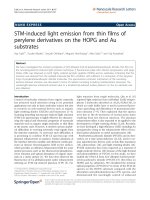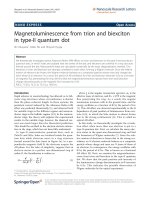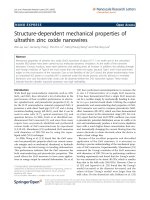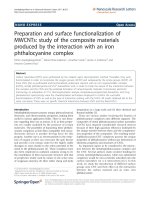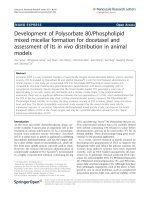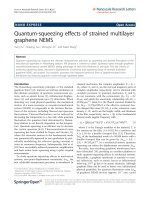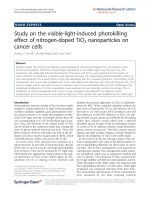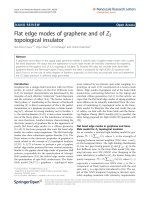Asedegbega-Nieto et al. Nanoscale Research Letters 2011, 6:353 pot
Bạn đang xem bản rút gọn của tài liệu. Xem và tải ngay bản đầy đủ của tài liệu tại đây (297.36 KB, 4 trang )
NANO EXPRESS Open Access
Preparation and surface functionalization of
MWCNTs: study of the composite materials
produced by the interaction with an iron
phthalocyanine complex
Esther Asedegbega-Nieto
1*
, María Pérez-Cadenas
1
, Jonathan Carter
2
, James A Anderson
2
and
Antonio Guerrero-Ruiz
1
Abstract
Carbon nanotubes [CNTs] were synthesized by the catalytic vapor decomposition method. Thereafter, they were
functionalized in order to incorporate the oxygen groups (OCNT) and sub sequently the amine groups (ACNT). All
three CNTs (the as-synthesized and functionalized) underwent reaction with an iron organometallic complex
(FePcS), iron(III) phthalocyanine-4,4”,4”,4""-tetrasulfonic acid, in order to study the nature of the interaction between
this complex and the CNTs and the potential formation of nanocomposite materials. Transmission electronic
microscopy, N
2
adsorption at 77 K, thermogravimetric analysis, temperature-programmed desorption, and X-ray
photoelectron spectroscopy were the characterization techniques employed to confirm the successful
functionalization of CNTs as well as the type of interaction existing with the FePcS. All results obtained led to the
same conclusion: There were no specific chemical interactions between CNTs and the fixed FePcS.
Introduction
Metallophthalocyanines possess unique physicochemical,
electronic, and electrocatalytic properties, making them
useful in various a pplication fields. There is vast litera-
ture regarding their use as sensors [1-3] as their proper-
ties are readily modified by the presence of certain
molecules. The possibility of depositing these phthalo-
cyanine complexes as thin films compatible with micro-
electronic devices is another driving force for this
purpose. Another use is as electrocatalysts in the reduc-
tion of oxygen as they can overcome the spin barrier
andprovidealow-energyrouteforthehighlystable
dioxygen to react, thanks to the redox potential of the
metal in the phthalocyanine [4]. These complexes have
also bee n employed as oxidation catalysts owing to (1)
the resemblance of their ma crocyclic structure with that
of porphyrins widely used by nature in the active sites
of oxygenase enzymes; ( 2) their rather cheap and facile
preparation on a large scale; and (3) their chemical and
thermal stability [5].
There are various studies involving the fixation of
phthalocyanine complexes onto different supports. The
composites of metal phthalocyanines/ca rbon nanotubes
[CNTs] have inspired considerable research interest
because of their high quantum efficiency facilitated by
the c harge transfer between them a nd the complemen-
tary properties of the composites. The resulting metal-
lophthalocyanine/CNT complexes possess the unique
propert ies of phth alocyanine without any destruction of
electronic properties and structures of CNTs.
An important aspect to be considered is the interac-
tion between t he metallophthalocyanine complex and
the CNT. S everal authors claim covalent bonding for
certain metallophthalocyanines, while non-substituted
complexes would be non-covalently adsorbed onto the
carbon nanotubes via π-π interactions [6,7]. In this
work, we study the introduction of different surface
groups onto CNT and their effect on the interaction
between the carbon material and an ionic iron
phthalocyanine.
* Correspondence: .es
1
Departamento de Química Inorgánica y Técnica, Facultad de Ciencias,
UNED, Paseo Senda del Rey no. 9, 28040 Madrid, Spain
Full list of author information is available at the end of the article
Asedegbega-Nieto et al. Nanoscale Research Letters 2011, 6:353
/>© 2011 Asedegbega-Nieto et al; licensee Springer. This is an Open Access article distributed under the terms of the Creative Commons
Attribution License ( which permits unr estricted use, distribution, and reproduction in
any medium, provided the original work is properly cited.
Experimental procedure
CNTs were synthesized by the catalytic vapor decompo-
sition method. The reaction setup and conditions are
described elsewhere [8]. The CNTs obtained were c he-
mically treated in order to functionalize the surface.
This consisted of a two-step procedure. Firstly, the ori-
ginally prepared CNTs were oxidized with HNO
3
(65
wt.%, 363 K, 72 h), thereby obtaining oxidized CNT,
which was f urther treated with an amine (ethylenedia-
mine in n-he xane, 343 K, 24 h) to give the aminated
CNT [ACNT]. The as-synthesized and treated CNTs
were reacted with a commercially available iron(III),
phthalocyanine -4,4”,4”,4""-tetrasulfonic acid (FePcS),
which is a hydrated monosodium salt compound that
contains oxygen (Sigma- Aldrich, St. Louis, MO, USA),
in order to obtain three composites, FePcS/CNTs (of 5
wt.% Fe). The procedure involved stirring 200 mg of
carbon nanotubes in an aqueo us solution of FePcS for
17 h at room temperat ure. After that, the solvent was
evaporated and the solid dried, 373 K for 18 h.
Various analyses were carried out in order to fully
characterize the prepared CNTs as well as the corre-
sponding composites. Transmission electronic micro-
scopy [TEM] was performed on synthesized CNTs
employing a JOEL JEM 2000FX system. Surface area
and pore size distribution were determined from N
2
adsorption at 77 K ( Micromeritics ASAP 2000 surface
analyzer). Samples were previously degassed at 393 K
for 5 h. Thermogravim etric analysis data were collected
using a SDTQ600 5200 TA system. The samples were
heated under an inert helium and air atmosphere (1,273
K, 10 K min
-1
). Temperature-programmed desorption
[TPD] experiments were perf ormed under vacuum in a
quartz reactor coupled with a mass spectrometer
(Baltzers, QMG 421, 1,100 K, 10 K min
-1
). The surface
of the CNTs and composites was analyzed by X-ray
photoelectron spectroscopy [XPS] with an Omicron
spectrometer system equipped with a hemispherical
electron analyzer operating in a constant pass energy
using Mg Ka radiation (hν =1,253.6eV).C1s,O1s,
N1s,Na1s,andFe2p
3/2
individu al high-res oluti on
spectra were measured. All binding energies were refer-
enced to C 1 s line at 284.6 eV.
Results and discussion
Carbon nanotubes
TEM results can be viewed in the micrographs of
Figure 1. As can be seen, the obtained carbon material
consists of bundles of multiwall ed CNTs of varying dia-
meters (generally between 10 and 20 nm).
Nitrogen adsorption isotherms at 77 K showed that all
CNTs displayed type II isotherms, which implies that the
samples contain mesopores and macropores [9]. Bru-
nauer-Emmett-Teller [BET] surface areas and me sopore
volumes are summarized in Table 1. As can be seen,
CNT has a surface area of 90 m
2
/g, which increased to
120 m
2
/g after surface oxidation. This is most likely due
to the eliminatio n of some retained Fe particles at tube
ends by the HNO
3
solution, thereby facilitating the N
2
access to the interior of the tubes. This opening, con-
fir med by TEM (not presented here for the sake of brev-
ity), would be responsible for the increase in surfa ce area.
However, after functionalizing these oxidized CNT sur-
faces with ethylenediamine, the surface area was lowered
to 82 m
2
/g, possibly due to restricted N
2
access resulting
from the coverage by the amine.
From the residual weights of materials after heat treat-
ment under helium, an increase in weight loss (due to
Figure 1 TEM images of originally synthesized CNTs. TEM, transmission electron microscopy.
Asedegbega-Nieto et al. Nanoscale Research Letters 2011, 6:353
/>Page 2 of 4
the elimination of surface groups) after the oxidation
process can be observed, and this increase is greater
after amination. This would indicate that modification
of the surface of the prepared CNTs was successful.
The evolution of CO and CO
2
was followed by TPD
experiments for all three CNT samples. The profiles
obtained gave an estimate of the surface oxygen-con-
taining groups. A significant increase was observed after
oxidation treatment of the synthesized CNTs, which
reveals that this chemical oxidation is an efficient way
to facilitate oxygen incorporation into CNTs. On the
other hand, the a mination of OCNT gave rise to a
reduction in the intensity of CO a nd CO
2
peaks due to
the decrease in the surface oxygen groups at the
expense of the newly formed amine groups. These TPD
results suggest that there is indeed interaction between
the acidic oxygen groups of the OCNT and the ethyle-
nediamine in the production of ACNT (Figure 2).
This variation noted in oxygen surface groups is
further confirmed upon observing the XPS results of O
1 s. In the first place, there was a significant increas e in
the atomic percent of o xygen (Table 1) after oxidizing
the originally prepared CNTs. This oxygen content is
strongly reduced after reacting OCNT with the amine
due to the formation of the co rrespondi ng amide. This
provides insight into t he type of interaction existing
between acidic oxygen groups and basic amine. This
could be further elucidated after dec onvolution of the O
1 s envelope into three peaks [10]. There was a notice-
able decrease (to almost half its initial value) in the
COOH peak (at about 534.4 eV) when comparing
ACNT with OCNT, which suggests acid/base reaction
to form water and the amide function. The nitrogen
functionalgroupatACNTisfurtherconfirmedbythe
presence of a N 1 s peak at 399.9 eV.
FePcS/CNT composites
The same characterization techniques also gave very
valuable in formation in the study of t he prepared com-
posites. Table 1 also collects thermogravimetric [TG]
results for the composite where there is a reduction in
theweight,whichfollowsthesametendencyasinthe
case of the starting CNTs. Subtracting from this weight
percent loss that of the corresponding CNT, an estimate
of the weight loss due to the incorporated complex can
be made. For all three composites, this value (17-19%) is
effectively constant, implying that si milar quantities of
the Fe complex have been fixed on the carbon substrate.
These T G analysis experiments under inert gas condi-
tions also reveal that deso rption/decompo sition of the
retained FePcS complexes take place at the same tem-
peratures in the three studied composites (TG profiles
are not shown for the sake of brevity). An obvious con-
clusion is that the interactions of the F ePcS molecules
with the CNT surfaces do not depend on the previous
functionalization of the carbon nanotube surfaces.
This is also supported by the XPS results where an
increase in atomic percent of Fe in the composite with
respect to that of the corresponding CNT can be attrib-
uted to the presence of the Fe complex in the compo-
site. This difference of about 0.15 is similar in all cases,
indicating that the amount of FePc at the surface of
each CNT is the same. The an choring of t he Fe com-
plex at the CNT surface was also evidenced by the pre-
sence of the S 2p and Na 1 s peaks . On the other hand,
binding energy values of the different components of
FePcS gave information on changes in the pure complex
due to its interaction with the CNT surface. The N 1 s
spectrum of phthalocyanines consists of one main peak
at 399.0 eV accompanied by a less inten sive peak at
Table 1 Characterization properties of CNTs
Sample BET morphological parameters TGA: residual weight (%) XPS at.% O 1 s
S
BET
(m
2
/g) V
mesopores
(cm
3
/g)
a
CNTs FePcS/CNTs
b
CNT 90 0.08 1.68 20.66 2.36
OCNT 120 0.11 4.88 22.17 7.69
ACNT 82 0.09 7.65 24.30 4.08
a
Volume of mesopores has been calculated by the difference between the volume of N
2
adsorbed at P/P° = 0.9 and P/P° = 0.2.
b
Residual weight of FePcS/CNT composites.
200 400 600 800 1000 120
0
CO
2
Intensity (a.u)
Temperature (K)
CNT
OCNT
ACNT
Figure 2 TPD profiles of the evolution of CO
2
.TPD,
Temperature-programmed desorption.
Asedegbega-Nieto et al. Nanoscale Research Letters 2011, 6:353
/>Page 3 of 4
400.6 eV. The main peak can be ascribed to the two
chemically non-equivalent nitrogens (four central nitro-
gens and four aza nitrogens), while the other peak is
attributed to a shake-up satellite [11]. In FeP cS/CNT
and FePcS/OCNT composites, similar band shape and
position were observed, indicating that N was present in
the same chemical environment as in i ts original pur e
commercial FePcS. As for FePcS/ACNT, these two
peaks were also present, although the proportions chan-
ged. The peak at higher binding energy is significantly
more intense owing to the participation of new amino
functional groups formed on the samples that are over-
lapped by the shake-up peak. Fe 2p
3/2
had binding ener-
gies of 710.20-710.95 eV in all three samples, and these
values are similar to that expected for FePcS [12] . This,
together with the doublet separation of about 13.5 eV
[13], confirms that Fe remains in its (+III) oxidation
state after composite formation. Therefore, FePcS in the
composite displays no significant difference with respect
to the original pure complex. It s eems that interactions
between this complex and the CNT are quite weak, do
not cause any chemical modification in the complex,
and are independent of the surface functionalization of
the support.
Conclusions
The functionalization of CNTs was successful and sig-
nificant amounts of oxygen surface groups and amine
groups were introduced into OCN T and ACNT, respec-
tively. Characterization of the composites gave very
valuable information. Firstly, independent of the pre-
sence of surface groups, the amount of fixed FePcS is
practically the same for all three CNTs. Secondly, the
chemical properties of this complex remain unchanged
in the composites. These two conclusions are indicative
of the interactions between ionic FePcS and surface-
modified CNTs. There seems to be no specific chemical
interaction, and th e weak π-π interactions ar e not influ-
enced by the presence of the functional groups on the
CNT surface.
Acknowledgements
The authors acknowledge MICINN Spain (Projects CTQ-2008-06839-C03-01-
PPQ) for the financial support.
Author details
1
Departamento de Química Inorgánica y Técnica, Facultad de Ciencias,
UNED, Paseo Senda del Rey no. 9, 28040 Madrid, Spain
2
Surface Chemistry
and Catalysis Group, Department of Chemistry, University of Aberdeen,
Regent Walk, Aberdeen, UK
Authors’ contributions
EAN carried out part of the characterization of CNT materials, the
interpretation of experimental data as well as writing up of this manuscript.
MPC and JC were responsible for synthesis and other characterizations of
CNT materials as well as interpretation of experimental data. JAA and AGR
participated in the supervision and aided in the result discussion and
manuscript revision. All authors read and approved the final manuscript.
Competing interests
The authors declare that they have no competing interests.
Received: 4 November 2010 Accepted: 20 April 2011
Published: 20 April 2011
References
1. de Saja JA, Rodriguez-Mendez ML: Sensors based on double-decker rare
earth phthalocyanines. Adv Colloid Interface Sci 2005, 116:1.
2. Hsieh JC, Liu CJ, Ju YH: Response characteristics of lead phthalocyanine
gas sensor: effects of film thickness and crystal morphology. Thin Solid
Films 1998, 322:98.
3. Shu JH, Wikle HC, Chin BA: Passive chemiresistor sensor based on iron (II)
phthalocyanine thin films for monitoring of nitrogen dioxide. Sens Actuat
B: Chem 2010, 148:498.
4. Zagal JH, Gulppi M, Isaacs M, Cárdenas-Jirón G, Aguirre MJ: Linear versus
volcano correlations between electrocatalytic activity and redox and
electronic properties of metallophthalocyanines. Electrochim Acta 1998,
44:1349.
5. Sorokin AB, Tuel A: Metallophthalocyanine functionalized silicas: catalysts
for the selective oxidation of aromatic compounds. Catal Today 2000,
57:45.
6. Moraes FC, Golinelli DLC, Mascaro LH, Machado SAS: Determination of
epinephrine in urine using multi-walled carbon nanotube modified with
cobalt phthalocyanine in a paraffin composite electrode. Sens Actuat B:
Chem 2010, 148:492.
7. Wang Y, Chen HZ, Li HY, Wang M: Fabrication of carbon nanotubes/
copper phthalocyanine composites with improved compatibility. Mater
Sci Eng 2005, 117:296.
8. Sampedro-Tejedor P, Maroto-Valiente A, Nevskaia DM, Múñoz V, Rodríguez-
Ramos I, Guerrero-Ruíz A: The effect of growth temperature and iron
precursor on the synthesis of high purity carbon nanotubes. Diamond
Rel Mater 2007, 16:542.
9. Rouquerol F, Rouquerol J, Sing K: Adsorption by Powders and Porous Solids
San Diego: Academic; 1999.
10. Soria-Sánchez M, Maroto-Valiente A, Álvarez-Rodríguez J, Rodríguez-Ramos I,
Guerrero-Ruíz A: Efficient catalytic wet oxidation of phenol using iron
acetylacetonate complexes anchored on carbon nanofibres. Carbon 2009,
47:2095.
11. Harnisch F, Savastenko NA, Zhao F, Steffen H, Brüser V, Schröder U:
Comparative study on the performance of pyrolyzed and plasma-treated
iron(II) phthalocyanine-based catalysts for oxygen reduction in pH
neutral electrolyte solutions. J Power Sources 2009, 193:86.
12. De Wael K, Westbroek P, Bultinck P, Depla D, Vandenabeele P, Adriaens A,
Temmerman E: Study of the deposition and Raman and XPS
characterization of a metal ion tetrasulphonated phthalocyanine layer at
gold surfaces: density functional theory calculations to model the
vibrational spectra. Electrochem Commun 2005, 7:87.
13. Muilenberg GE: Handbook of X-ray Photoelectron Spectroscopy Minnesota:
Perkin-Elmer Corp; 1979.
doi:10.1186/1556-276X-6-353
Cite this article as: Asedegbega-Nieto et al.: Preparation and surface
functionalization of MWCNTs: study of the composite materials
produced by the interaction with an iron phthalocyanine complex.
Nanoscale Research Letters 2011 6:353.
Asedegbega-Nieto et al. Nanoscale Research Letters 2011, 6:353
/>Page 4 of 4

